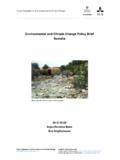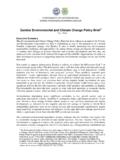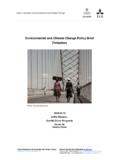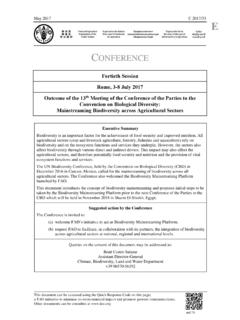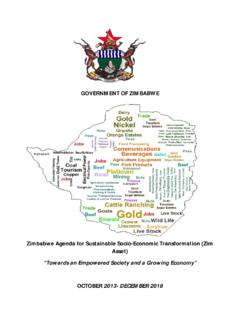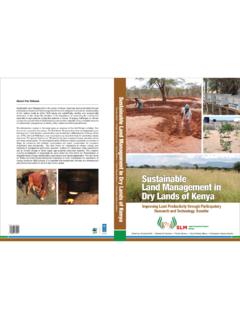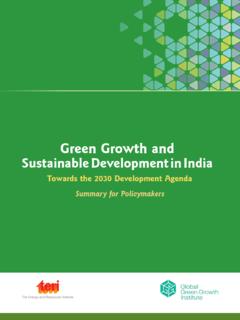Transcription of Ethiopia Environmental and Climate Change policy …
1 Sida's Helpdesk for Environment and Climate Change Contact: Emelie C sar Ethiopia Environmental and Climate Change policy brief Photo: Emelie C sar 2013-05-27 Emelie C sar Anders Ekbom This Environmental and Climate Change policy Brief was written, at the request of Sida (Torsten Andersson and Andrea Molnar, Swedish Embassy, Ethiopia ) by Emelie C sar and Anders Ekbom at Sida s Helpdesk for Environment and Climate Change . The views expressed in this Environmental and Climate Change policy Brief are those of the authors and do not necessarily represent the views of Sida. Provision of relevant information is gratefully acknowledge from: Hailemariam Teklewold (EfD/University of Gothenburg), Stein Holden (Norwegian University of Life Sciences), Yonas Alem (EfD/University of Gothenburg), and Haileselassie Mehdin (EfD/University of Gothenburg). Comments are welcome and can be sent to 2 Table of Contents 1. Introduction .. 3 2. Key Environmental problems, their causes and opportunities.
2 4 3. What are the effects of the Environmental problems? .. 6 Impacts on poverty .. 6 Economic development .. 7 Impacts on Public Health and Education .. 8 4. policy framework for managing Environmental challenges .. 10 Policies, laws and regulations .. 10 International obligations .. 11 National priorities .. 11 Mainstreaming of environment and Climate Change in the policy framework .. 12 Governance, enforcement and implementation .. 12 Capacity constraints .. 13 5. Risks and opportunities .. 14 Risks .. 14 Opportunities .. 15 6. Other issues .. 18 Addressing MDG 7 .. 18 Addressing resilience .. 18 Land reform and transitions .. 19 Increasing population waste disposal management and sustainability .. 21 The use of Environmental impact assessment .. 21 Infrastructure development and energy .. 22 Links between environment and human rights, inequities and gender .. 23 Khat - health and Environmental issues .. 24 7. Conclusions.
3 24 8. Issues for Sida to consider .. 25 References .. 27 Annex I Ethiopia GDP growth rate per sector .. 31 Annex II Ethiopian policies, laws and regulations .. 32 3 1. Introduction During the last couple of years Ethiopia has had a remarkable economic growth (an average of 10%/year) and the country has achieved notable progress towards many of the millennium development goals (MDGs), including those for poverty, access to education and health. Improvements have also been made in basic infrastructure and in strengthening both regional and national policies and governance capacity. Today over 80 million people live in Ethiopia , and over 80% are living in rural areas. Population growth remains high at 2% and Ethiopia is expected to reach over 120 million people by 20301. Ethiopia s economy and ecological system are fragile and vulnerable to Climate Change . Environmental challenges in Ethiopia include Climate Change , soil degradation, deforestation, loss of biodiversity and ecosystem services, and pollution of land, air and water.
4 Ethiopia s economy is also highly dependent on natural resources. Exploitation of these natural resources may generate large economic benefits in the short term. However, in the long term unsustainable use of these natural resources increases not only Environmental degradation, but decreases economic growth and livelihood opportunities. The key poverty-environment linkages in Ethiopia are related to: Environmental health concerns related to malnutrition, polluted water and indoor air pollution; vulnerability to natural disasters and Climate Change ; lack of secure tenure to land and other natural resources; and unreliable access to food and water. Ethiopia s vision is to reach a middle-income status by 2025. Over the last two decades, the Ethiopian government has put in place a number of policies, strategies and laws that are designed to support sustainable development and the country is set to move towards a greener economy.
5 There are gaps between the Environmental commitments made and the actual implementation to improve Environmental outcomes. Weak capacity in Environmental management and enforcement are key challenges. This environment and Climate Change policy brief aims at briefly presenting key Environmental sustainability challenges and opportunities in Ethiopia , their linkages to poverty reduction and socio-economic development. 1 Government of Ethiopia , 2012 4 2. Key Environmental problems, their causes and opportunities The most important Environmental problems in Ethiopia include, Climate Change , land degradation, overgrazing and deforestation, indoor air pollution and water pollution. Other, important Environmental problems include loss of biodiversity and ecosystem services, spread of invasive alien species, urban outdoor air pollution (mainly in Addis Ababa), and toxic household Climate Change : The Ethiopian population is experiencing Climate Change and its impacts on the environment and natural resources.
6 Continued Climate Change is expected to bring greater variability, and extreme weather events ( droughts) which will further drive degradation of the country s The impact of Climate Change in Ethiopia is already apparent in the increasing temperature and declining rainfall, particularly in northern parts which are exceptionally vulnerable to drought. Agriculture is the source of livelihood to an overwhelming majority of the Ethiopian population (it employees more than 80% of the labour force4) and is the basis of the national economy. A decrease in seasonal rainfall has devastating implications on agricultural production leading to food insecurity, malnutrition and famine. The frequency and intensity of drought is likely to increase over the coming decades, which will present a serious threat to biodiversity, ecosystems, water, agricultural and human health. Impacts of increased Climate variability and Change include (i) increased food insecurity; (ii) outbreaks of diseases such as malaria, dengue fever and water borne diseases such as cholera and dysentery due to floods, and (iii) respiratory diseases associated with droughts; (iv) heavy rainfalls which tend to accelerate land degradation and damage to communication infrastructure.
7 Land degradation: Land degradation is one of the most serious problems in Ethiopia . In addition to natural factors such as rainfall and erodible soils, population pressure, overgrazing, unsustainable land use and expansion of farming causes severe land degradation which affects agricultural productivity. Furthermore, land degradation leads to loss of vegetation cover and loss of biodiversity and ecosystem services. The estimated annual costs of land degradation in Ethiopia range from 2% to of agricultural Deforestation: Forests cover of Ethiopia . Deforestation is widespread. The average annual deforestation rate is 1% which is high compared to other Sub-Saharan African countries ( ).6 The growing population requires more fuel wood and more agricultural production which increase needs for new farmland, which accelerates deforestation and forest degradation. It is estimated that unless action is taken to Change the traditional development path, an area of 9 million ha might be deforested between 2010 and 2030.
8 Over the same period, annual fuel wood consumption will rise by 65% with large effects on forest Indoor air pollution: Indoor air pollution is a serious Environmental problem causing acute respiratory illness (ARI). It hits the poorest the most, particularly women and children. These problems are mainly caused by the poor households use of traditional polluting stoves and 2 European Commission, 2007 3 World Bank 2012 4 MoFED, 2006 5 Yesuf et al, 2007 6 World Bank, 2012c 7 Government of Ethiopia , 2012 5 woody biomass, which is their major source of energy for cooking, heating and lighting. About 95% of Ethiopia s energy supply comes from woody biomass, mainly fuel wood (77%), dung (8%), crop residues (9%) and charcoal (1%). Electrification mainly for lighting is concentrated in the urban areas. Electrification of the rural areas is increasing but still limited.
9 Only about one household in every four (23%) has electricity, with a very large disparity between urban and rural Water pollution and lack of access: Water pollution constitutes a large risk to Ethiopia s public health, mainly caused by high levels of organic pollutants and water-borne diseases. Access to safe water in terms of improved water sources is very poor. In rural areas only 39% of the population have access to improved water sources. Compounded with the extremely limited access to improved sanitation (19%) in rural areas, the prevalence of water-borne diseases is therefore very high. Estimates show that over 112 000 people die every year due to water and sanitation-related diseases. Children are most vulnerable to lack of safe and improved water and sanitation. Prevalence of diarrhoea among children under is high among children that drink water from unprotected wells (18%).
10 A recent health survey showed that one in four children (between 6-23months) had diarrhoea within a two-week period of the Reflection: The main drivers of Environmental degradation in Ethiopia include high population growth, high urbanisation rate, as well as an economic growth that is largely driven by agricultural production, infrastructure expansion and increasing energy demand. Key Environmental challenges for Ethiopia include Climate Change , soil degradation and Climate Change leading to variability in temperature and rainfall is expected to increase further over the past century. More droughts and floods will have negative impacts on agricultural production and negatively affect the national economy and peoples Although some progress has been made Ethiopia faces many challenges towards achieving the MDG 7 - Ensure Environmental sustainability. Efforts have been made to increase forested areas, however total land area covered by forest has decreased from to since 2000.
